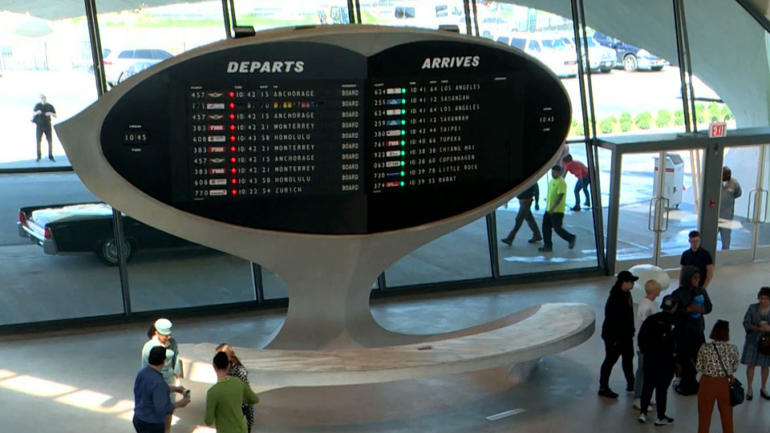The 1960s are considered by many to be the golden age of travel. Jet planes were taking off, but air travel was not yet the common and crowded activity it has become.
Now, thanks to a $265 million renovation, an iconic terminal designed by a noted architect from that era has been transformed into a boutique hotel that takes travelers back in time. CGTN’s Karina Huber has more.
There might finally be a good reason to visit an airport widely considered one of the worst in America.
It’s the new TWA Hotel at JFK Airport in New York, and it’s quickly becoming an Instagram-worthy attraction.
When it opened as a passenger terminal in 1962, it was an instant hit.
“The TWA terminal designed by Eero Saarinen is arguably the most important iconic, historic airline terminal in the world,” said Richard Southwick, a partner in the architectural firm Beyer Blinder Belle.
But TWA’s financial problems caused it to be shut down in 2001. The building remained empty for almost two decades.
Now it is back as a boutique hotel with over 500 rooms, 4600 square meters of event space, six restaurants and a rooftop infinity pool overlooking the runway.
The hotel rooms are housed in two new buildings designed by Anne Marie Lubrano of Lubrano Ciavarra Architects.
“I consider the Saarinen building to be probably the sexiest building in America, if not the world. And so, I was so overwhelmed with emotion really to just have the opportunity to work with this building,” she said.
Lubrano was told the Saarinen building had to be the center of attraction. It couldn’t be upstaged. So, she kept the design simple.
But designing the windows wasn’t so simple. Guests would need to get a good night’s sleep, which was a challenge with planes taking off at all hours.
The solution — windows with seven layers of glass.
“On the South building, you can look out over the bay runway and you see planes take off, but you cannot hear a thing,” Lubrano promises.
Southwick, the architect behind the overhaul of the flight center, the world’s largest hotel lobby, says no expense was spared to stay true to Saarinen’s vision.
His firm commissioned roughly 20 million white penny tiles from a company in China that resemble the Italian-made tiles used in the original space.
“If you look around there’s no square corner in the building,” said Southwick. The floor transitions into the walls, into the ceilings and you can only do these really complex and really expressive geometric shapes with a tile that’s about so big – about the size of your thumb nail.”
Throughout the space, you’ll find mid-century furniture and 1960s memorabilia, including outfits worn by TWA flight attendants, the signature clock and a restored departure board with its unique clicking sound.
Visiting the TWA Hotel feels very much like being transported back in time to the 1960s. But there are a few things from that period you won’t find today, like ashtrays and 1960s prices.
But you can still get a stiff cocktail in the hotel’s signature bar housed inside a restored Lockheed Constellation airplane.
The rebirth of the building is a win for historic preservationists. The building was about to be bulldozed, but Southwick says officials quickly came to their senses.
“They knew that even though they could tear it down, they would not want to be the author of making that decision.”
Any fan of the jet age’s heyday would have to agree.
Larry Yu on new guest experiences, innovations and challenges for the hotel industry
CGTN’s Rachelle Akuffo spoke with Larry Yu, Professor of Hospitality Management, the George Washington University, about innovations and challenges in the hotel industry.
 CGTN America
CGTN America

